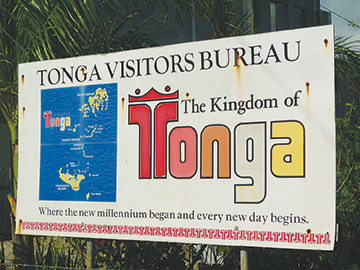Sailing in the Kingdom of Tonga; navigation time on the edge of the dateline (published June 2014)
A Canadian, an American and an Australian are sitting in the shade of a thatched roof bar having cold beers when a 150-pound pig walks in. The barman turns and yells “Charlie!” The large pig snorts when he hears his name and saunters in out of the sun. The Australian turns to the Canadian, lifts his beer and says, “Welcome to the Kingdom of Tonga.” That might sound like the beginning of a bad joke, but it is just another day in Neiafu for Steve and me.
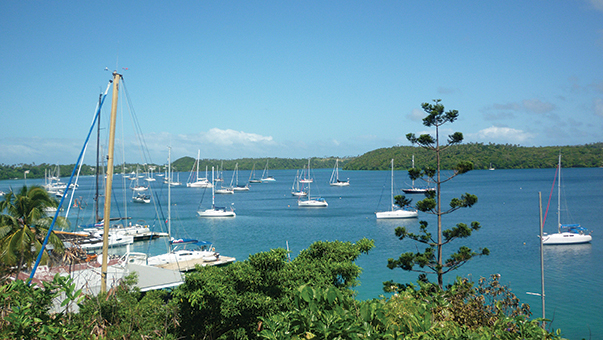 Located between the Pacific islands of Niue and Fiji, “Tonga”, meaning south in many pacific languages, is part of the Polynesian Triangle. The Kingdom is made up of 176 small islands that are grouped into four regions: Tongatapu, the Ha’apai, Vava’U and the Niuas. Scattered over 700,000 square kilometres of the southern Pacific Ocean, only a handful of these islands are home for the 103,000 people that call themselves Tongan. History, custom and independent spirit run deep in Tonga, and you can feel it. This is a place that has never crumbled under the weight of colonization, where a King still rules his Kingdom.
Located between the Pacific islands of Niue and Fiji, “Tonga”, meaning south in many pacific languages, is part of the Polynesian Triangle. The Kingdom is made up of 176 small islands that are grouped into four regions: Tongatapu, the Ha’apai, Vava’U and the Niuas. Scattered over 700,000 square kilometres of the southern Pacific Ocean, only a handful of these islands are home for the 103,000 people that call themselves Tongan. History, custom and independent spirit run deep in Tonga, and you can feel it. This is a place that has never crumbled under the weight of colonization, where a King still rules his Kingdom.
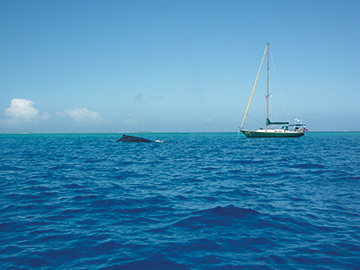 Every year people flock to Tonga for different reasons; for the great diving, clear visibility and pristine coral, to swim with wild humpback whales, for the internationally renowned sport fishing and for the parties and festivities held every September and October during Regatta Vava’u. For some it is just another stop along the Coconut Milk Run, a spot to provision and another country to check off the list in the rush across the great Pacific Ocean in one frenzied season. But for a lot of Kiwis and Aussies, and the handful of other boats, like us, that hang around the Pacific year round, it is a place to come back to time and again. Whether you are able to visit for a few days, a few weeks or a few months, the Kingdom of Tonga invites you to slow down, unwind and explore. It is definitely not untouched, unsullied or undiscovered, but it is beautiful, remote and exotic. To me it is pretty close to paradise.
Every year people flock to Tonga for different reasons; for the great diving, clear visibility and pristine coral, to swim with wild humpback whales, for the internationally renowned sport fishing and for the parties and festivities held every September and October during Regatta Vava’u. For some it is just another stop along the Coconut Milk Run, a spot to provision and another country to check off the list in the rush across the great Pacific Ocean in one frenzied season. But for a lot of Kiwis and Aussies, and the handful of other boats, like us, that hang around the Pacific year round, it is a place to come back to time and again. Whether you are able to visit for a few days, a few weeks or a few months, the Kingdom of Tonga invites you to slow down, unwind and explore. It is definitely not untouched, unsullied or undiscovered, but it is beautiful, remote and exotic. To me it is pretty close to paradise.
TONGATAPU
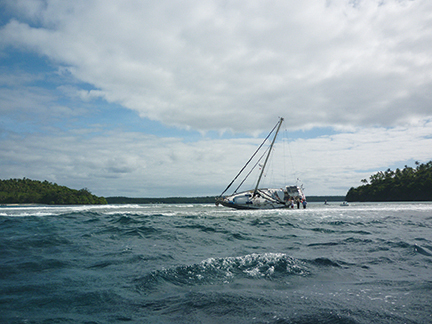 Sailing to the Kingdom of Tonga for the first time, from the east, was exciting. We passed over the International Dateline and shared in the confusing phenomenon of time travel without ever having to leave the safety of the cockpit. We quickly learned that Tonga was a place where you can go off the charts. Not only can you escape to your own tropical paradise, but you can also find the little boat icon on your chartplotter racing across land. It is well known that the charts in Tonga are notoriously incorrect and incomplete. There are several unmarked hazards, missing buoys and lights that no longer function. Without local knowledge, these waters are no place to travel at night, to enter anchorages at dusk or to be caught looking at your chartplotter instead of over your bow. When we motored into Nuku’alofa Harbour, the shoreline was littered with wrecks. Hulking, rusty hulls resting like macabre tombstones remind mariners to be vigilant. Navigating here is not difficult; it just demands attention.
Sailing to the Kingdom of Tonga for the first time, from the east, was exciting. We passed over the International Dateline and shared in the confusing phenomenon of time travel without ever having to leave the safety of the cockpit. We quickly learned that Tonga was a place where you can go off the charts. Not only can you escape to your own tropical paradise, but you can also find the little boat icon on your chartplotter racing across land. It is well known that the charts in Tonga are notoriously incorrect and incomplete. There are several unmarked hazards, missing buoys and lights that no longer function. Without local knowledge, these waters are no place to travel at night, to enter anchorages at dusk or to be caught looking at your chartplotter instead of over your bow. When we motored into Nuku’alofa Harbour, the shoreline was littered with wrecks. Hulking, rusty hulls resting like macabre tombstones remind mariners to be vigilant. Navigating here is not difficult; it just demands attention.
We tied to the jagged stone wharf with our Q flag raised and waited. The check-in procedures were painless and the officials pleasant, and the fact that we were well accustomed to “Island Time” didn’t hurt either. We found the adjacent anchorage had a sandy bottom in less than 15 meters of water, cause alone to celebrate in this part of the world. And then I realized that I had finally made it to the place that for years Steve had described as “one of his favorite stops in the South Pacific.”
When we caught up on sleep and headed ashore, we were informed by Tourism Tonga that we had discovered “Where each new day begins.” But the more we explored the capital city, the more I wondered if this wasn’t the place where time stood still.
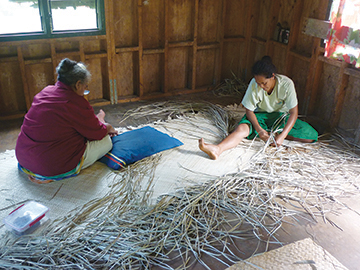 Strolling down the waterfront from the small boat marina in Nuku’alofa, or the “Mainland,” as many islands further north call it, I was struck by the contrast between the old ways and the new world. Instant Noodle packaging littered the streets as far as the eye could see. Hundreds of years of being able to drop coconut husks and palm frond parcels and have them absorbed by the earth was a habit it seemed that people had yet to shake. I heard the staccato rhythm of women beating their tapa cloth over the drone of morning traffic, the pulse of tradition and the hum of modernity fighting for my attention. It was commonplace to see people in the streets wearing a ta’ovala, a large hand-woven mat, wrapped about them. And yet just as frequently, I saw young girls parading in stilettos and distressed skinny jeans. Packs of pigs, ubiquitous in Tonga, roamed the streets, snuffling along in the grass and nosing about in the cool dirt. Everyone carried a cell phone, whether there was a signal to receive or not. I couldn’t decide if it was a clash of the times or a confusing ballet playing out before me.
Strolling down the waterfront from the small boat marina in Nuku’alofa, or the “Mainland,” as many islands further north call it, I was struck by the contrast between the old ways and the new world. Instant Noodle packaging littered the streets as far as the eye could see. Hundreds of years of being able to drop coconut husks and palm frond parcels and have them absorbed by the earth was a habit it seemed that people had yet to shake. I heard the staccato rhythm of women beating their tapa cloth over the drone of morning traffic, the pulse of tradition and the hum of modernity fighting for my attention. It was commonplace to see people in the streets wearing a ta’ovala, a large hand-woven mat, wrapped about them. And yet just as frequently, I saw young girls parading in stilettos and distressed skinny jeans. Packs of pigs, ubiquitous in Tonga, roamed the streets, snuffling along in the grass and nosing about in the cool dirt. Everyone carried a cell phone, whether there was a signal to receive or not. I couldn’t decide if it was a clash of the times or a confusing ballet playing out before me.
HA’APAI
While in the Ha’apai group whale sightings far outnumbered the times we saw other boats. Humpbacks come to these temperate waters to calve and frolic for the southern winter months. During the month we explored these islands, we shared an anchorage with one other boat for four nights and saw a half a dozen more in passing. I stopped counting whales one afternoon when during a quick sail we saw more than a dozen. The quiet, private moments watching a mother and calf laze on the surface or the spectacle of a young male breaching and splashing, like an inexhaustible toddler, never fails to capture my imagination—no matter how many times I see them.
We found an assortment of idyllic anchorages, some ringed with vibrant coral reefs, others overlooking long white sandy beaches—all of them with breathtaking vistas. We spent as much time in the water as on it, with visibility this good it was hard to stay dry. And below the surface I discovered some of the healthiest reefs I have yet to see, teaming with colorful fish, dotted with neon sponges and hiding an assortment of nudibranchs and anemones. The snorkeling was so good we didn’t even drag out the dive tanks. Why strap on all that gear when there was so much within reach of the surface?
The only downside to this area is that the majority of the anchorages give protection from the prevailing winds and little, if any, protection from other directions. When a front blew through we were left feeling like Goldilocks; this cove is too small to swing in all directions, that one lets in too much swell. When the wind shifted after dark, we’d spend nights doubting our decisions and ourselves. Unable to sleep we swapped places on the settee sitting anchor watch trying to judge our position by the outline of a palm tree ashore or the crash of surf on a nearby reef.
Like most good things in life paradise doesn’t come for free, but sometimes it is worth missing a few hours of sleep to wake up and look out onto your own little slice of heaven.
VAVA’U
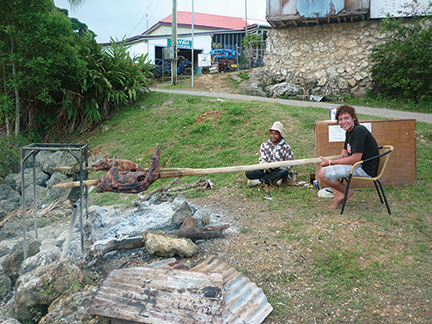 The town of Neiafu, the administrative capital for the northern islands of Vava’u, is a hotspot for yachties. The harbor is large, protected and easy to access. The majority of Puddle Jumpers make this their port of entry. You can buy fresh veggies, good meats and fresh made bread ashore. Laundry services, Internet access and the all-important cold beer are readily available.
The town of Neiafu, the administrative capital for the northern islands of Vava’u, is a hotspot for yachties. The harbor is large, protected and easy to access. The majority of Puddle Jumpers make this their port of entry. You can buy fresh veggies, good meats and fresh made bread ashore. Laundry services, Internet access and the all-important cold beer are readily available.
This town is no stranger to tourism, as the waterfront is a patchwork of restaurants offering everything from tacos to pastas, curry to pizza, Swiss rosti to Canadian poutine. Whether you’re looking for a quiet drink and good company by the pool, some fun and laughs with friends at an Open Mic, or a late night dance session after you take in the Fakaleiti show (translating as “In the Manner of a Lady”, or “Like a Lady”), this place has it all. Moorings and Sunsail have set up shop here, guaranteeing that easy sailing and good anchorages are nearby. The people are friendly and the living is easy. Most people find it hard to drop the mooring lines and leave the harbor.
But just beyond the harbor buoys is some of the finest sailing in the Pacific. The tall volcanic islands shield the inner waterways from the deep ocean swell while moderate southeast trade winds blow almost year round. Within a few hours you can be at one of the 40 plus anchorages marked on the local charts and on most days you won’t even have to turn on your engine to get there. Several of the outer island villages welcome visitors, with some even hosting traditional Tongan feast nights and handicraft displays. You can explore underwater caves, snorkel vibrant coral gardens, stop for lunch on a white sand beach or just spend the day tacking through the islands.
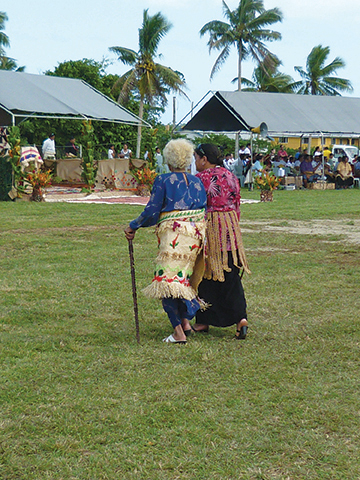 While in Vava’u there is an assortment of activities to take in. You can go out with a certified dive operator or whale watching company, take a day trip to the botanical garden, or explore the islands by Go Kart. We liked participating in the regular Friday night friendly yacht race held by the Port of Refuge Yacht Club. The races around the cans are always fun with prizes donated by local businesses, and cold beers to boast or commiserate over afterwards. If organized activities are not your thing you can go for a hike, hire a bicycle or rent a car to explore the islands in your own way, on your own time.
While in Vava’u there is an assortment of activities to take in. You can go out with a certified dive operator or whale watching company, take a day trip to the botanical garden, or explore the islands by Go Kart. We liked participating in the regular Friday night friendly yacht race held by the Port of Refuge Yacht Club. The races around the cans are always fun with prizes donated by local businesses, and cold beers to boast or commiserate over afterwards. If organized activities are not your thing you can go for a hike, hire a bicycle or rent a car to explore the islands in your own way, on your own time.
A great resource while you’re in the area is VHF channel 26. Several years ago the Vava’u Sport Fishing Club installed a series of repeater towers so they could monitor boats fishing further offshore. Today, this system is used by fisherman and yachtsmen alike. Some local personalities volunteer their time year round to host a morning VHF net, with the main focus being weather reports and emergency traffic. And it works. While there, we had the unfortunate opportunity to hear a yacht being rescued from running aground; a singlehander arranged a tow into port after shredding sails and disabling his engine during a particularly rough night underway; and a local dive company get help during a medical emergency at sea.
We generally like to be where everyone else is not and during the summer high season of July through October, Neiafu can be a little overwhelming. But, even when the harbor is awash in dinghy wake, the mooring field is full, the radio is buzzing with traffic and a constant stream of boats parades down the channel, you can still get away from it all.
In today’s high tech world of Google Earth and navigation apps it is close to impossible to get off the beaten track. And while it might take a little effort to sail away from the trappings of modernity, especially if you haven’t seen them in a long time, the rewards are worth it. What could be better than watching a perfect Pacific sunset slip below the horizon from an almost empty anchorage? To me that sounds like a good reason to raise a beer to yet another unbelievable day in the Kingdom of Tonga.
Heather Francis is originally from Nova Scotia, Canada and has been sailing with her partner, Steven Hertik, on board their Newport 41 Kate since 2008. They have spent the last three years in the South Pacific. To follow their adventures log onto www.yachtkate.com.















